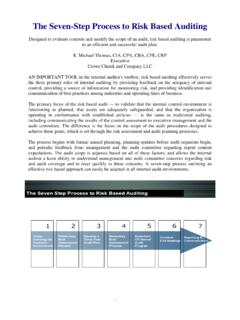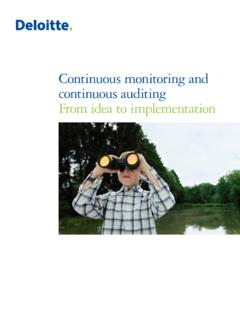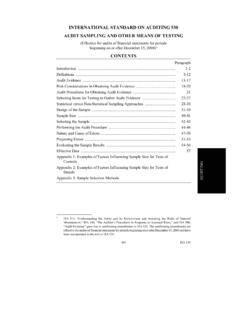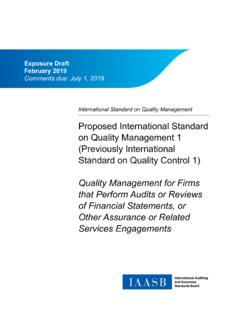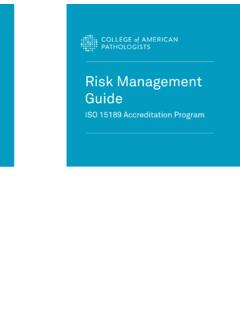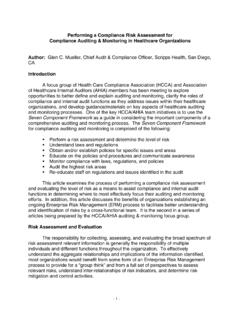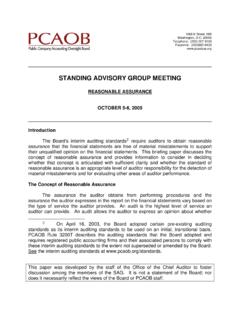Transcription of CHAPTER 9 AUDITING THE REVENUE CYCLE - Yola
1 A U D I T I N G A RISK- based APPROACH TO CONDUCTING A QUALITY AUDIT 9th Edition Karla M. Johnstone | Audrey A. Gramling | Larry E. Rittenberg Copyright 2014 South-Western/Cengage Learning CHAPTER 9 AUDITING THE REVENUE CYCLE Copyright 2014 South-Western/Cengage Learning 9- 2 LEARNING OBJECTIVES the significant accounts, disclosures, and relevant assertions in the REVENUE CYCLE and assess inherent risks of material misstatement in the REVENUE CYCLE and assess fraud risks of material misstatement in the REVENUE CYCLE and assess control risks of material misstatement in the REVENUE CYCLE Copyright 2014 South-Western/Cengage Learning 9- 3 LEARNING OBJECTIVES how to use preliminary analytical procedures to identify possible material misstatements for REVENUE CYCLE accounts, disclosures.
2 And assertions appropriate responses to identified risks of material misstatement for REVENUE CYCLE accounts, disclosures, and assertions appropriate tests of controls and consider the results of tests of controls for REVENUE CYCLE accounts, disclosures, and assertions Copyright 2014 South-Western/Cengage Learning 9- 4 LEARNING OBJECTIVES and apply sufficient appropriate substantive audit procedures for testing REVENUE CYCLE accounts, disclosures, and assertions the frameworks for professional decision making and ethical decision making to issues involving the audit of REVENUE CYCLE accounts, disclosures, and assertions Copyright 2014 South-Western/Cengage Learning 9- 5 THE AUDIT OPINION FORMULATION PROCESS Copyright 2014 South-Western/Cengage Learning 9- 6 PROFESSIONAL JUDGMENT IN CONTEXT - HOW TO ACCOUNT FOR VIRTUAL SALES AT ZYNGA REVENUE recognition approaches of Ernst & Young Game- based - REVENUE is recognized very slowly User- based - Faster approach that lasts till user sticks with the game Speedy item- based - based on properties of individual virtual goods Changing player life allowed Zynga to change a net loss for the six month period into net profit of $ million Copyright 2014 South-Western/Cengage Learning 9- 7 PROFESSIONAL JUDGMENT IN CONTEXT - HOW TO ACCOUNT FOR VIRTUAL SALES AT ZYNGA What are the inherent risks
3 Associated with REVENUE transactions? (LO 2) What are management s incentives to misstate REVENUE transactions? (LO 3) What controls should management have in place to mitigate the risks associated with REVENUE transactions? (LO 4) Copyright 2014 South-Western/Cengage Learning 9- 8 PROFESSIONAL JUDGMENT IN CONTEXT - HOW TO ACCOUNT FOR VIRTUAL SALES AT ZYNGA How might auditors use preliminary analytical procedures to identify any potential concerns related to REVENUE ? (LO 5) What is sufficient appropriate evidence when AUDITING REVENUE transactions and related accounts? (LO 6, 7, 8) IDENTIFY THE SIGNIFICANT ACCOUNTS, DISCLOSURES, AND RELEVANT ASSERTIONS IN THE REVENUE CYCLE LEARNING OBJECTIVE 1 Copyright 2014 South-Western/Cengage Learning 9- 10 REVENUE CYCLE Process of: Receiving a customer s order Approving credit for a sale Determining whether goods are available for shipment Shipping the goods Billing the customers Collecting cash Recognizing effect of this process on other related accounts Copyright 2014 South-Western/Cengage Learning 9- 11 REVENUE CYCLE Significant accounts include REVENUE and accounts receivable Evidence is obtained for each financial statement assertions Relevance of assertions varies with accounts and clients More relevant assertions.
4 Have risk of material misstatement Require higher-quality audit evidence Copyright 2014 South-Western/Cengage Learning 9- 12 EXHIBIT - REVENUE CYCLE ACCOUNTS: AFFECTED BY SALES TRANSACTIONS Copyright 2014 South-Western/Cengage Learning 9- 13 EXHIBIT - REVENUE CYCLE ACCOUNTS: AFFECTED BY SALES TRANSACTIONS IDENTIFY AND ASSESS INHERENT RISKS OF MATERIAL MISSTATEMENT IN THE REVENUE CYCLE LEARNING OBJECTIVE 2 Copyright 2014 South-Western/Cengage Learning 9- 15 PERFORMING RISK ASSESSMENT PROCEDURES IN THE REVENUE CYCLE Requires information about: Inherent risks at the: Financial statement level Account and assertion levels Fraud risks Feedback from audit team s brainstorming session Strengths and weaknesses in internal control Results from preliminary analytical procedures Copyright 2014 South-Western/Cengage Learning 9- 16 REVENUES: IDENTIFYING INHERENT RISKS Timing of REVENUE recognition - Important inherent risk related to REVENUE transactions Following information is required to audit REVENUE CYCLE Organization s principal business Earnings process and nature of obligations that extend beyond normal shipment of goods Impact of unusual terms, and when title passes to customer Copyright 2014 South-Western/Cengage Learning 9- 17 REVENUES.
5 IDENTIFYING INHERENT RISKS Right of customer to return a product, as well as returns history Contracts that are combinations of leases and sales Proper treatment of sales transactions made with recourse or that have an abnormal or unpredictable amount of returns Copyright 2014 South-Western/Cengage Learning 9- 18 CRITERIA FOR REVENUE RECOGNITION Refer to guidance provided by: International Accounting Standards Board (IASB) Securities and Exchange Commission (SEC) Financial Accounting Standards Board (FASB) American Institute of Certified Public Accountants (AICPA) Copyright 2014 South-Western/Cengage Learning 9- 19 CRITERIA DETERMINED BY SEC FOR REVENUE RECOGNITION Persuasive evidence of an arrangement should exist Delivery should have occurred, or services should have been rendered The seller s price to the buyer should be fixed or determinable Collectibility should be reasonably assured Copyright 2014 South-Western/Cengage Learning 9- 20 CRITERIA DETERMINED BY SEC FOR REVENUE RECOGNITION It does not consider delivery to have occurred until customer.
6 Takes title of ownership Assumes risks and rewards of ownership Auditors need to determine: When a client should recognize REVENUE How to audit REVENUE Copyright 2014 South-Western/Cengage Learning 9- 21 AUDITING IN PRACTICE - CHANNEL STUFFING AT ARTHROCARE Highlights material misstatements that can occur if: Client record REVENUE improperly Auditor fails to detect misstatement Channel stuffing improperly inflated company REVENUE and earnings Sales personnel shipped products to distributors even though the distributers did not: Need them Have the ability to pay them Copyright 2014 South-Western/Cengage Learning 9- 22 ACCOUNTS RECEIVABLE: IDENTIFYING INHERENT RISKS Receivables pledged as collateral against specific loans with restricted use Receivables incorrectly classified as current when likelihood of collection during next year is low Collection of a receivable contingent on specific events that cannot currently be estimated Payment not required until purchaser sells product to its end customers Accounts receivable aged incorrectly, and potentially uncollectible amounts not recognized Orders accepted from customers with poor credit.
7 But allowance for doubtful accounts not increased accordingly IDENTIFY AND ASSESS FRAUD RISKS OF MATERIAL MISSTATEMENT IN THE REVENUE CYCLE LEARNING OBJECTIVE 3 Copyright 2014 South-Western/Cengage Learning 9- 24 FRAUD SCHEMES UNCOVERED BY THE SEC AND PCAOB Recognition of REVENUE on shipments that never occurred Hidden side letters giving customers an irrevocable right to return the product Recording consignment sales as final sales Creation of fictitious invoices Shipment of more product than customer ordered Early recognition of sales that occurred after end of fiscal period Copyright 2014 South-Western/Cengage Learning 9- 25 FRAUD SCHEMES UNCOVERED BY THE SEC AND PCAOB Shipment of unfinished product Shipment of product before customers wanted or agreed to delivery Recording shipments to company s own warehouse as sales Recording reshipment as a sale of new goods before issuing credit for the returned sale Incorrect aging of accounts receivable Recording purchase orders as completed sales Copyright 2014 South-Western/Cengage Learning 9- 26 LAPPING Technique used to cover up embezzlement of cash Stealing cash collection from a customer and crediting him from another customer's payment This process continues and at least one customer s account is always overstated Occurs when duties are inadequately segregated Copyright 2014 South-Western/Cengage Learning 9- 27 AUDITING IN PRACTICE - IMPORTANCE OF PROFESSIONAL SKEPTICISM IN AUDITING REVENUE AT TVIA It is
8 Important to be alert when client personnel have significant financial motives to fraudulently overstate REVENUE To prevent such behavior it is important to understand and test controls designed and implemented If controls are ineffective: Exercise appropriate professional skepticism Extend substantive testing Copyright 2014 South-Western/Cengage Learning 9- 28 AUDITOR S ROLE IN IDENTIFYING FRAUD RISK FACTORS Assessing motivation to enhance REVENUE because of either internal or external pressures Reviewing financial statements through preliminary analytical procedures Recognizing that not all of the fraud will be instigated by management Becoming aware of representations made by management to analysts Potential effect of those expectations on stock prices Copyright 2014 South-Western/Cengage Learning 9- 29 AUDITOR S ROLE IN IDENTIFYING FRAUD RISK FACTORS Determining whether company s performance is significantly different from rest of the industry or economy
9 Determining whether company s accounting is being investigated by organizations such as the SEC Considering management compensation schemes Determining whether accounting functions are centralized If not, assessing if decentralization is appropriate Copyright 2014 South-Western/Cengage Learning 9- 30 AUDITOR S ROLE IN IDENTIFYING FRAUD RISK FACTORS Assessing whether company engages in complex sales arrangements Assessing whether company has a history of aggressive accounting interpretations Determining that an uninterrupted history of growth in earnings per share or REVENUE might provide incentives to continue to show that growth Determining if client has numerous manual journal entries affecting REVENUE process Copyright 2014 South-Western/Cengage Learning 9- 31 AUDITING IN PRACTICE - RISKS RELATED TO DECENTRALIZED ACCOUNTING FUNCTIONS AT WORLDCOM Prime example of taking several actions that negatively affect quality of its
10 Financial statements Complex transactions were made difficult to understand and audit because: Accounting personnel were not sufficiently qualified Accounting function was spread over three locations without a good rationale for decentralization Decentralization was by function IDENTIFY AND ASSESS CONTROL RISKS OF MATERIAL MISSTATEMENT IN THE REVENUE CYCLE LEARNING OBJECTIVE 4 Copyright 2014 South-Western/Cengage Learning 9- 33 IDENTIFYING CONTROL RISKS Requires understanding of internal controls for integrated audits and financial statement only audits Such understanding is gained by means of: Walkthrough of the process Inquiry Observation Review of client s documentation Copyright 2014 South-Western/Cengage Learning 9- 34 IDENTIFYING CONTROL RISKS At acco
